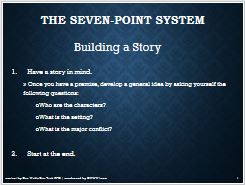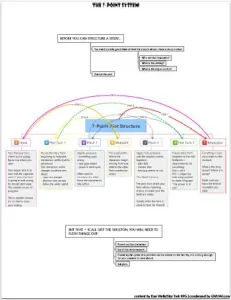Last year, Dan Wells, author of “I Am Not A Serial Killer” went over a story structure he found in the “Star Trek Narrator’s Guide: Roleplaying Game“, which he renamed as the 7-Point System. He generously shared his PowerPoint presentation which can be found here (which includes 2 story examples), but as usual, I felt having a summarized version would help.
TABLE OF CONTENTS
- What is a 7 Point Story Structure?
- How to Use the 7 Point Story Structure
- Free Downloads
- Pin It!
- Posts in Series:
- Mailing List
- Follow via WordPress
What is a 7 Point Story Structure?
The 7 point plotting system focuses on the 7 major events that take place in all stories. It’s a good place to start when you’re first developing your plot and want to ensure you have the right tent poles up.
How to Use the 7 Point Story Structure
To begin, you would need to:
- have a story idea in mind.
- develop the premise by asking yourself the following 3 basic questions:
1) who are the characters?
2) where is it set?
3) what is the major conflict? - start at the end (see steps below)
The 7 Points
- Hook
- Plot Turn 1
- Pinch 1
- Midpoint
- Pinch 2
- Plot Turn 2
- Resolution
Work Through the 7 Point Story Structure in the Following Order
Step 1: Resolution
What is your story about? Everything in your story leads to this moment. Where is your story going?
Step 2: Hook
Once you know where you’re going, figure out where you start. One simple trick is to start at the opposite state. If your character is going to end strong, s/he should start weak. The story will be about the progression of your character from one state to the other.
Step 3: Midpoint
The exact center between the two states. It is the point at which your character begins moving from one state to the other. And from reaction to action.
Step 4: Plot Turn 1
The point between the beginning and the midpoint. Just as the midpoint moves you from the beginning to the end, Plot Turn 1 moves you from the beginning to the middle. This is where you introduce the conflict and where your character’s world changes. S/he meets new people, discovers secrets and follows the white rabbit.
Step 5: Plot Turn 2
Moves you from midpoint to the end. The midpoint is when your character decides to take action. The end is when your character does what decided to do. Plot Turn 2 is when your character discovers the final thing needed to make it happen. “The power is within you!”
Step 6: Pinch 1
This occurs between Plot Turn 1 and the Midpoint. Right after your character’s world changes and they discover new things, something goes wrong. This is where you introduce your villain. Usually this is where your characters are forced into taking action (the midpoint stage).
Step 7: Pinch 2
This occurs right after the Midpoint. It’s another pressure point and it’s considered the darkest moment in the story. It’s when all hope is lost. Your character loses his/her mentor, the plan fails, the bad guys seem to win. These are the jaws from which your hero will be snatching victory. Make sure the teeth are sharp.
Free Downloads
Below you can find PDF summaries and a storyboard-like 7 point story structure template to help you develop your own story.
Condensed Version of Original 7 Point System Powerpoint by Dan Wells
7-Point System: Condensed Powerpoint
Includes two 7 point plot structure examples:
- Harry Potter & the Philosopher’s Stone (main plot thread)
- The Matrix (main plot & subplots – a similar template to develop your own story can be found directly below)
7 Point Story Structure Template
Instructions
- List main plot & subplot across the top ribbons
- Describe the plot point for each plot thread according to the 7 point story structure.
One Page PDF Summary – Mind Map Format
One Page PDF Summary – Table Format
Pin It!
Posts in Series:
- Part 1: Writing Method: Snowflake by Randy Ingermanson (Printable Summaries)
- Part 2: Writing Method: 7-Point System by Dan Wells (Printable Summaries)
- Part 3: Writing Method: Writing into the Dark (Pantsers) by Dean Wesley Smith
- Part 4: Writing Method: Making a Mess by Me 🙂
- Part 5: Writing Method: 3 Act/9 Block/27 Chapter Outline by Kat O’Keeffe (Printable Summaries)
- Part 6: Writing Method: Plot Structure by Jenna Moreci (Printable Worksheets)
Mailing List
For notes on books, MasterClasses, writing & finance, click here to get notified when new posts go live on GWUWI.com



